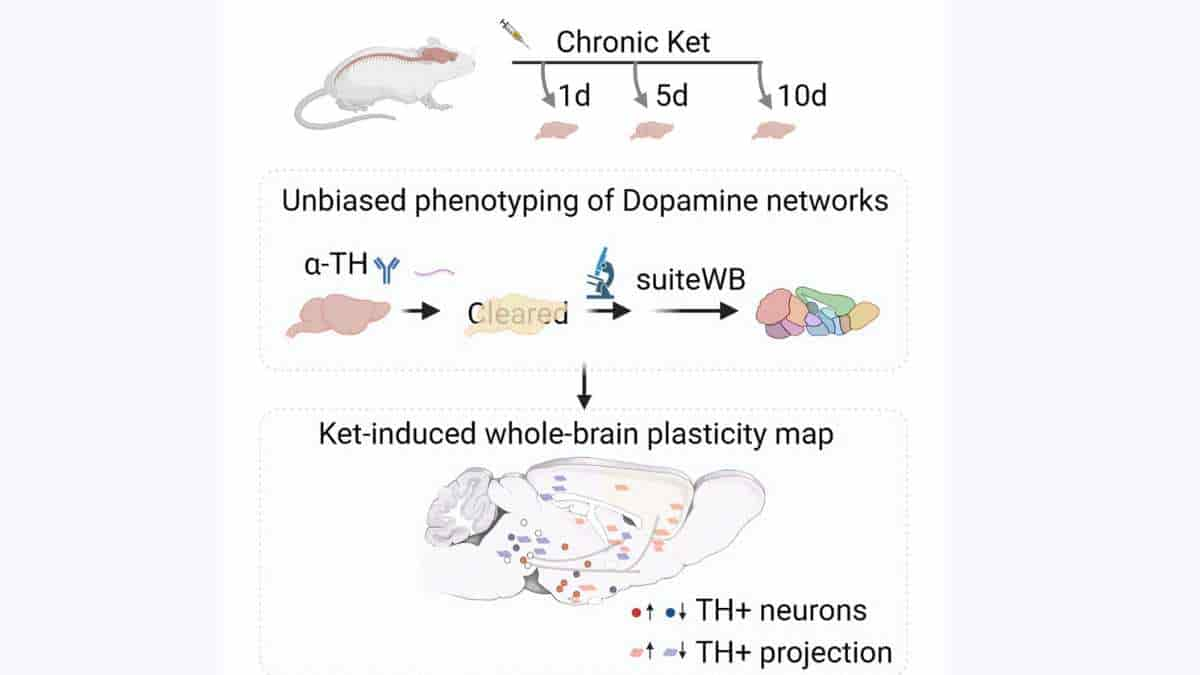Columbia University biologists and biomedical engineers traced ketamine’s effects on the brains of mice in a new study, discovering that repeated usage over long periods of time promotes broad structural changes in the brain’s dopamine system. The findings support the development of ketamine therapies that target specific areas of the brain rather than administering ketamine doses that wash the entire brain in ketamine.
“Instead of bathing the entire brain in ketamine, as most therapies now do, our whole-brain mapping data indicates that a safer approach would be to target specific parts of the brain with it, so as to minimize unintended effects on other dopamine regions of the brain,”
said senior author Raju Tomer.
Increased Hypothalamus Dopamine
Ketamine, an anesthetic also renowned for its illicit recreational usage, has undergone extensive reputational rehabilitation in recent years as the medical community has begun to understand its broad therapeutic potential. The substance is increasingly being utilized for a variety of medicinal purposes, including as an opioid-free pain reliever and as a treatment for treatment-resistant depression.
The Columbia study found that repeated ketamine exposure leads to a decrease in dopamine neurons in regions of the midbrain that are linked to regulating mood, as well as an increase in dopamine neurons in the hypothalamus, which regulates the body’s basic functions like metabolism and homeostasis.

The first result, that ketamine reduces dopamine in the midbrain, may explain why long-term ketamine misuse may cause users to exhibit symptoms comparable to those seen in patients with schizophrenia, a mental illness. The latter discovery, that ketamine raises dopamine in brain regions that regulate metabolism, may help explain why it shows potential in treating eating disorders.
Potential Cognitive Behavioral Change Links
The researchers’ very detailed data also allowed them to study how ketamine impacts dopamine networks across the brain. They found that ketamine lowered the density of dopamine axons, or nerve fibers, in the parts of the brain responsible for hearing and vision while increasing dopamine axons in the brain’s cognitive centers.
These intriguing findings may help explain the dissociative behavioral effects observed in individuals exposed to ketamine.
“The restructuring of the brain’s dopamine system that we see after repeated ketamine use may be linked to cognitive behavioral changes over time,”
Malika Datta, a co-author of the paper said.
Chronic Ketamine Exposure Mapped
Most studies of ketamine’s effects on the brain to date have looked at the effects of acute exposure — how one dose affects the brain in the immediate term. For this study, researchers examined repeated daily exposure over the course of up to 10 days.
Statistically significant alterations to the brain’s dopamine makeup were only measurably detectable after ten days of daily ketamine use.
The researchers studied the effects of repeated medication exposure at two dosages, one similar to the dose used to model depression treatment in rats and another closer to the level that induces anesthesia. The effects of the medication on the dopamine system were obvious at both doses.
“The study is charting a new technological frontier in how to conduct high-resolution studies of the entire brain,”
said Yannan Chen, a co-author of the paper. It is the first successful attempt to map changes caused by chronic ketamine exposure at “sub-cellular resolution,” or seeing ketamine’s effects on parts of individual cells.
Essential Step for Targeted Treatments
Most sub-cellular studies of ketamine’s effects conducted to date have been hypothesis-driven investigations of one area of the brain that researchers have targeted because they believed that it might play an important role in how the brain metabolizes the drug. This study is the first sub-cellular study to examine the entire brain without first forming such a hypothesis.
“Ketamine rapidly resolves depression in many patients with treatment-resistant depression, and it is being investigated for longer-term use to prevent the relapse of depression. This study reveals how ketamine rewires the brain with repeated use. This is an essential step for developing targeted treatments that effectively treat depression without some of the unwanted side effects of ketamine,”
Bradley Miller, a Columbia psychiatrist and neuroscientist who focuses on depression, said.
This study provides researchers with a more comprehensive understanding of how ketamine works in the brain, which they hope will lead to better uses of this highly promising drug in a variety of clinical settings while also reducing its recreational abuse.
“More broadly, the study demonstrates that the same type of neurons located in different brain regions can be affected differently by the same drug,”
said Tomer.
Reference:
- Malika S. Datta,Yannan Chen,Shradha Chauhan,Jing Zhang,Estanislao Daniel De La Cruz,Cheng Gong,Raju Tomer. Whole-brain mapping reveals the divergent impact of ketamine on the dopamine system. Cell Reports, DOI: 10.1016/j.celrep.2023.113491
Top image credit: Cell Reports, DOI: 10.1016/j.celrep.2023.113491.
